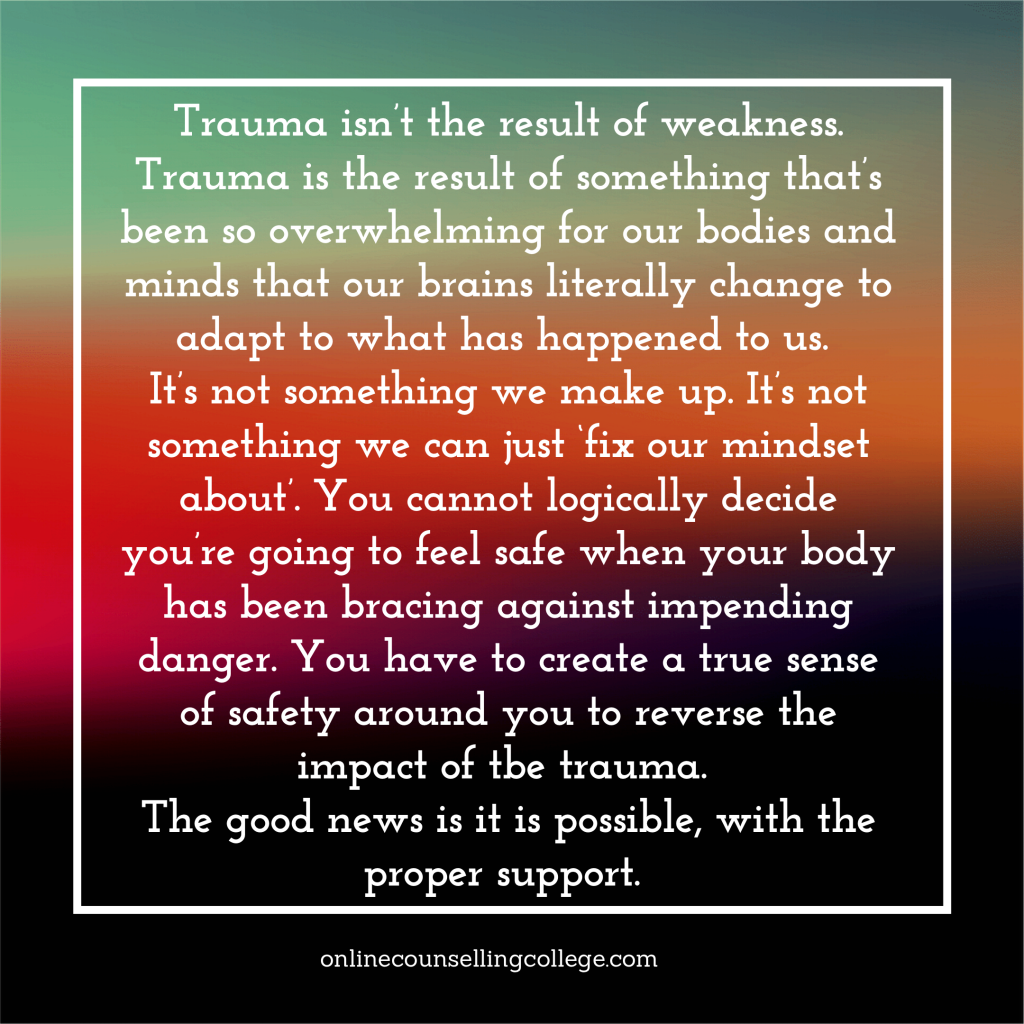
Does the term trauma vortex mean anything to you?
This metaphor describes the swirling whirlpool of emotions, reactions and thoughts that a trauma stirs in us. It’s where sensations, pictures, sounds or painful memories are triggered unexpectedly, and take us back in time[1]. This is summed up well in the following definition:
“Trauma is like a magnet or a black hole sucking us in. Memories of trauma are not like normal memories of something that happened in another time and place, but instead we feel like we are currently in that other time and place. When triggered, our feelings are very powerful and pull us further and further into … a trauma vortex (a whirling mass that draws things towards its centre).[2]”
And when an individual feels that they’re being sucked into this hole:
- They’re subjected to an onslaught of disturbing thoughts and pictures related to the trauma, or distressing life event.
- They feel they’re being pulled into obsessively reviewing, or ruminating over, the traumatic incident.
- It’s likely they’ll be struggling with despair, emptiness, abandonment, rejection and a sense of hopelessness.
- At the same time, they feel worthless, and are swamped by guilt and shame.
- Life feels unpredictable – which makes them insecure
- The symptoms that assault them make them feel they’re going crazy.
So how can we help someone who is in this anguished state? Some possible suggestions include the following:
1. Diverting the person’s attention away from painful memories. This can be achieved by:
(a) Helping to ground them in the present. That is, asking them what they can see in their immediate environment (such as a plant, or the sun shining outside the window); or hear (such as a phone ringing); or smell (such as strong coffee, or dinner cooking, or freshly cut grass); or feel (such as the rough fabric on the sofa, the smoothness of a glass they are holding); or taste (such as tea they are sipping, or the gum they are chewing).
(b) Taking the person off to a safe place in their mind (for example, through the use of guided imagery).
2. Choosing different channels to process the experience so they’re not focused on feelings or distressing images. For example, if the person is fixated on how they feel emotionally, you could ask him or her to describe the way they’re feeling physically. This will generally lessen the emotional response.
3. Suggesting they try to distract themselves by doing something very different. This moves the focus away from the traumatic memory[3].
“Leaving something, even momentarily, will help decrease its pull on you. Imagine if you stepped out of a movie theatre just as the film was becoming really scary. How different would it be if you left the movie ten times rather than sat through the whole thing spellbound? This is true with internal experiences as well. Give yourself breaks. Oscillate attention.”
All of these can help to bring us back to the present where the danger has passed, and we are safe, and have control.
“Trauma isn’t the result of weakness ...Trauma is the result of something that’s been so overwhelming for our bodies and minds that our brains literally change to adapt to what has happened to us. It’s not something we make up. It’s not something we can just ‘fix our mindset about’. You cannot logically decide you’re going to feel safe when your body has been bracing against impending danger. You have to create a true sense of safety around you to reverse the impact of the trauma. The good news it is possible, with the proper support.” – Unknown
[2] Cori, J.L. (2009). Healing from trauma: A survivor’s guide to understanding your symptoms and reclaiming your life. Boston, MA: Da Capo Lifelong Books.
[3] Cori, J.L. (2009). Healing from trauma: A survivor’s guide to understanding your symptoms and reclaiming your life. Boston, MA: Da Capo Lifelong Books.

I didn’t know how much I needed that read.
LikeLiked by 2 people
I’m glad you found the post helpful ❤️
LikeLike
A vortex is a good way to describe it. Thank you for the valuable advice 🙏
LikeLiked by 1 person
Thanks for taking the time to read and comment 🙂
LikeLiked by 1 person
These are very helpful thoughts. It’s comforting to know there are ways to get out of the vortex of reliving traumatic experiences. Thank you for sharing this extremely practical advice. Have a blessed weekend. 🙏❤️
LikeLiked by 2 people
Thanks David. Wishing you a peaceful and blessed weekend too 🙂
LikeLiked by 1 person
Reblogged this on Disablities & Mental Health Issues.
LikeLiked by 1 person
Thanks so much!
LikeLike
Thank you so much!! Having a bad spell lately and this is so helpful!!❤❤
LikeLike
I’m sorry you are having such a tough time. Thinking of, and praying, for you 💕
LikeLike
Brilliant.. this is the way Peter Levine works with trauma, painful triggers can be so magnetizing but there is also a healing vortex and we enter that when we do not allow the whirlpool to take us down so easily or at least try to dip our toe in a positive memory, experience or image.. there is a very moving part in his book Waking the Tiger where he works with someone with abuse memories as she goes in and out and then feels herself rolling about in a pile of leaves while hugging herself. it made me cry reading it to my therapist this week as she suffered invasive bodily trauma like me..
LikeLiked by 1 person
That is a really great description of the healing vortex. Everyone should read Peter Levine’s books. One of the true experts in the field. I have found his insights extremely helpful on a personal level. Thanks for sharing this!
LikeLike
I wish his work was more widely known.
LikeLiked by 1 person
I feel like I need to read this again and again as a reminder to myself that I need proper healing.
LikeLike
I’m sorry you’ve experienced trauma in your life. The effects of trauma don’t just disappear. We need to consciously work on our healing.❤️
LikeLiked by 1 person
Reblogged this on Survivors Blog Here Mental Health Collaborative .
LikeLike